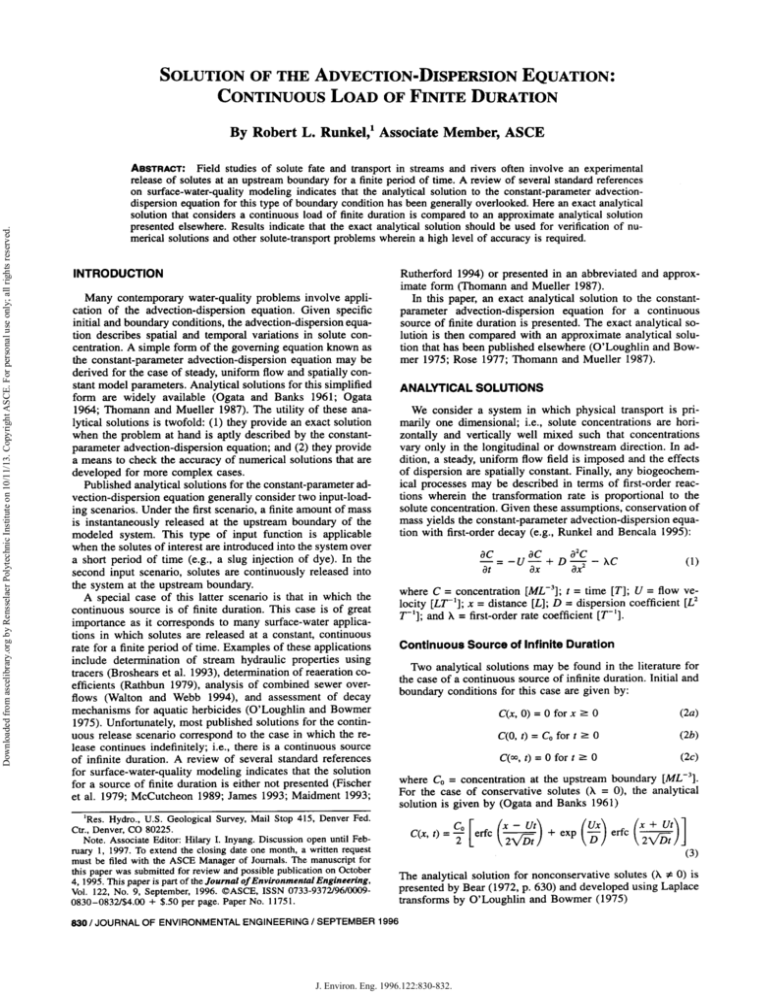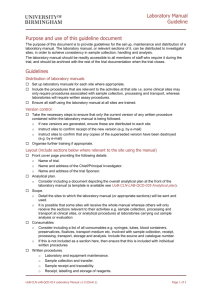
SOLUTION OF THE ADVECTION-DISPERSION EQUATION:
CONTINUOUS LOAD OF FINITE DURATION
Downloaded from ascelibrary.org by Rensselaer Polytechnic Institute on 10/11/13. Copyright ASCE. For personal use only; all rights reserved.
By Robert L. Runkel, l Associate Member, ASCE
ASSTRACT: Field studies of solute fate and transport in streams and rivers often involve an experimental
release of solutes at an upstream boundary for a finite period of time. A review of several standard references
on surface-water-quality modeling indicates that the analytical solution to the constant-parameter advectiondispersion equation for this type of boundary condition has been generally overlooked. Here an exact analytical
solution that considers a continuous load of finite duration is compared to an approximate analytical solution
presented elsewhere. Results indicate that the exact analytical solution should be used for verification of numerical solutions and other solute-transport problems wherein a high level of accuracy is required.
INTRODUCTION
Many contemporary water-quality problems involve application of the advection-dispersion equation. Given specific
initial and boundary conditions, the advection-dispersion equation describes spatial and temporal variations in solute concentration. A simple form of the governing equation known as
the constant-parameter advection-dispersion equation may be
derived for the case of steady, uniform flow and spatially constant model parameters. Analytical solutions for this simplified
form are widely available (Ogata and Banks 1961; Ogata
1964; Thomann and Mueller 1987). The utility of these analytical solutions is twofold: (1) they provide an exact solution
when the problem at hand is aptly described by the constantparameter advection-dispersion equation; and (2) they provide
a means to check the accuracy of numerical solutions that are
developed for more complex cases.
Published analytical solutions for the constant-parameter advection-dispersion equation generally consider two input-loading scenarios. Under the first scenario, a finite amount of mass
is instantaneously released at the upstream boundary of the
modeled system. This type of input function is applicable
when the solutes of interest are introduced into the system over
a short period of time (e.g., a slug injection of dye). In the
second input scenario, solutes are continuously released into
the system at the upstream boundary.
A special case of this latter scenario is that in which the
continuous source is of finite duration. This case is of great
importance as it corresponds to many surface-water applications in which solutes are released at a constant, continuous
rate for a finite period of time. Examples of these applications
include determination of stream hydraulic properties using
tracers (Broshears et al. 1993), determination of reaeration coefficients (Rathbun 1979), analysis of combined sewer overflows (Walton and Webb 1994), and assessment of decay
mechanisms for aquatic herbicides (O'Loughlin and Bowmer
1975). Unfortunately, most published solutions for the continuous release scenario correspond to the case in which the release continues indefinitely; Le., there is a continuous source
of infinite duration. A review of several standard references
for surface-water-quality modeling indicates that the solution
for a source of finite duration is either not presented (Fischer
et al. 1979; McCutcheon 1989; James 1993; Maidment 1993;
'Res. Hydro., U.S. Geological Survey, Mail Stop 415, Denver Fed.
Clr., Denver, CO 80225.
Note. Associate Editor: Hilary I. Inyang. Discussion open until February I, 1997. To extend the closing date one month, a written request
must be filed with the ASCE Manager of Journals. The manuscript for
this paper was submitted for review and possible publication on October
4, 1995. This paper is part of the Journal ofEnvironmental Engineering,
Vol. 122, No.9, September, 1996. ©ASCE, ISSN 0733-9372/96/00090830-0832/$4.00 + $.50 per page. Paper No. 11751.
Rutherford 1994) or presented in an abbreviated and approximate form (Thomann and Mueller 1987).
In this paper, an exact analytical solution to the constantparameter advection-dispersion equation for a continuous
source of finite duration is presented. The exact analytical solution is then compared with an approximate analytical solution that has been published elsewhere (O'Loughlin and Bowmer 1975; Rose 1977; Thomann and Mueller 1987).
ANALYTICAL SOLUTIONS
We consider a system in which physical transport is primarily one dimensional; Le., solute concentrations are horizontally and vertically well mixed such that concentrations
vary only in the longitudinal or downstream direction. In addition, a steady, uniform flow field is imposed and the effects
of dispersion are spatially constant. Finally, any biogeochemical processes may be described in terms of first-order reactions wherein the transformation rate is proportional to the
solute concentration. Given these assumptions, conservation of
mass yields the constant-parameter advection-dispersion equation with first-order decay (e.g., Runkel and Bencala 1995):
ac
ac
-ac
at = -u -ax + D -ax
2
2
(1)
- 'hC
where C = concentration [ML- 3 ]; t = time [T]; U = flow velocity [LT- 1]; x = distance [L]; D = dispersion coefficient [L2
T- 1]; and A = first-order rate coefficient [T-'].
Continuous Source of Infinite Duration
Two analytical solutions may be found in the literature for
the case of a continuous source of infinite duration. Initial and
boundary conditions for this case are given by:
= 0 for x :2: 0
C(O, t) = Co for t :2: 0
C(x, 0)
C(oo, t)
= 0 for t
:2:
0
(2a)
(2b)
(2c)
where Co = concentration at the upstream boundary [ML -3].
For the case of conservative solutes (A = 0), the analytical
solution is given by (Ogata and Banks 1961)
C(x, t)
Co [
(x - Ut)
="2
erfc 2VDt
+ exp
(ux)
+ Ut)]
D erfc (x2VDt
(3)
The analytical solution for nonconservative solutes (A :¢;. 0) is
presented by Bear (1972, p. 630) and developed using Laplace
transforms by O'Loughlin and Bowmer (1975)
830/ JOURNAL OF ENVIRONMENTAL ENGINEERING / SEPTEMBER 1996
J. Environ. Eng. 1996.122:830-832.
C(x, t)
Co { exp
="2
[ux
2D (1 -
ux (1 +
+ exp [ 2D
f)
] erfc (x 2Viii
- Utf)
+ Utf)}
f) ] erfc (x 2Viii
(4)
where
f
= VI + 2H
Downloaded from ascelibrary.org by Rensselaer Polytechnic Institute on 10/11/13. Copyright ASCE. For personal use only; all rights reserved.
H= 2ADIU
(5)
2
(6)
Simplified forms of (3) and (4) are often presented in the
literature. Ogata and Banks (1961) state that omission of the
second term in (3) results in a maximum error of 3% for values
of D/Ux < 0.002. Similarly, it can be shown using L'Hospital's
theorem that the terms in (4) involving x + Ut are small relative to the other terms (O'Loughlin and Bowmer 1975). Following these ideas, (4) simplifies to
C(x, t) =
~o {exp [ : (1 -
f)]
erfc (x 2-:);)}
(7)
Because the error introduced by dropping the x + Ut terms
is usually less than that associated with experimental data, the
simplification yielding (7) is frequently employed. Eq. (7) may
be further simplified by noting that for small H (on the order
of 0.(025), r can be approximated by the first two terms in a
binomial expansion [f ... 1 + H, O'Loughlin and Bowmer
(1975)]
C(x, t)
= ~o {exp (-~x) erfc (x - ~~+ Hl)}
(8)
This second simplification is far less typical than the first,
and was introduced by O'Loughlin and Bowmer (1975) in
order to derive an expression for the estimation of A. from field
data.
Continuous Source of Duration T
Although these solutions are of interest, a far more useful
problem is that in which a continuous source is present for a
finite period of time. Letting T represent the duration of the
continuous source [T], initial and boundary conditions are
given by
C(x, 0)
= 0 for x
~
0
(9a)
= Co for T ~ t ~ 0
(9b)
C(O, t)
= 0 for t > T
(9c)
C(oo, t)
= 0 for t
(9d)
C(O, t)
~
0
An analytical solution for the conditions given in (9) was
developed by Rose (1977) in a commentary on the work of
O'Loughlin and Bowmer (1975). Rose correctly applied the
principle of superposition to (8), yielding an approximate analytical solution. For t :5 T, the solution is given by (8). For
t > T, the solution is
C(x, t)
= ~o exp (-~x)
_ erfc
[x - U(t -
{erfc [x -
T)(1
+
2VD(t - or)
assumption of small H. This original work has been cited and
reproduced in a popular and widely read textbook (Thomann
and Mueller 1987). Due to the simplifying assumptions, (10)
is only an approximate analytical solution for the problem at
hand. An exact analytical solution may be obtained by applying the principle of superposition to the original analytical solution for a continuous source of infinite duration (4). The
solution for t :5 T is given by (4). For t > T, superposition
yields
~~+ H)]
H)]}
(10)
Recall that the primary purpose of the work presented by
O'Loughlin and Bowmer (1975) and Rose (1977) was to estimate A. from field data. As such, application of superposition
using the simplified equation was justified, given the stated
assumption that terms involving x + Ut are small and the
C(x, t)
= ~o {exp [~~ (1
-
f)]
[erfc
(x 2~f)
- erfc
(x2V~~ =~f)] + exp [~~ (l + 0]
. [erfc
(\+JT) - (x 2V~~t =~)f)
erfc
]}
(11)
A similar solution that considers the additional processes of
retardation and zero-order production for subsurface applications is given by van Genuchten and Alves (1982).
RESULTS AND CONCLUSIONS
An exact analytical solution to the advection-dispersion
equation subject to a continuous load of finite duration is given
by (11). Development of the approximate analytical solution
given as (10) relies on two assumptions regarding the parameter groups D/Ux and H. The errors associated with the use of
the approximate solution are therefore problem specific. Here
we examine these errors through a hypothetical example. In
the example, a continuous source with a 2-hr duration (T = 2
he) is imposed such that the concentration at the upstream
boundary is 100 concentration units (Co = 100). The flow velocity and dispersion coefficient are fixed (at 0.1 mis and 5.0
m 2/s, respectively) and the parameter groups D/Ux and H are
allowed to vary as a function of distance (x) and decay rate
(A.).
Results for the hypothetical example are shown graphically
in Fig. 1. Figs. l(a) and l(b) show the results for a conservative solute (A. = 0) at 100 and 2,000 m, respectively. Errors
(the discrepancy between the exact and approximate analytical
solution) in this case are due entirely to the initial assumption
that the term involving x + Ut is small relative to the other
term in (3). As suggested by Ogata and Banks (1961), the error
should decrease as D/Ux becomes small. This is verified by
comparing errors at the first location [Fig. 1(a), x = 100m]
with those at the second location [Fig. l(b), x = 2,000 m], and
noting that the errors decrease as D/Ux decreases from 0.5 to
0.025. Figs. I(c) and led) show the results for a nonconservative solute (A. = I X 10- 4 ) at 100 and 2,000 m. For a nonconservative solute, errors are due to both the initial assumption that the x + Vt terms are small and the additional
assumption that H is small. Comparison of Figs. I(a) and I(c)
indicates that the error introduced by the additional assumption
is negligible for short distances (small values of x). In contrast,
the assumption of small H introduces considerable error at
longer distances, as suggested by a comparison of Figs. I (b)
and I(d).
The errors depicted in Fig. I are quantified in Table I where
the maximum error is given as a percentage of the peak concentration. In general, the errors associated with the use of the
approximate analytical solution decrease with increasing distance for a conservative solute (D/Vx decreases with x) and
increase with increasing A. for a nonconservative solute. An
exception to this trend is noted at x = 100 m, where the percent
error is relatively insensitive to the specified value of A. This
exception is due to the short transport time that limits the
effect of decay.
JOURNAL OF ENVIRONMENTAL ENGINEERING / SEPTEMBER 1996/831
J. Environ. Eng. 1996.122:830-832.
x = 100 meters
x=2000meters
100
The writer thanks Steven Chapra, Jonathan Nelson, and Robert Broshears for their review of this manuscript.
),-0.0
80
Max EIror. 16.8%
APPENDIX I.
60
40
-Exact (Eqn 11)
Approx. (Eqn 10)
20
·1
J
0
Downloaded from ascelibrary.org by Rensselaer Polytechnic Institute on 10/11/13. Copyright ASCE. For personal use only; all rights reserved.
100
), = Ixlo-'
80
Max EIror = 16.3%
60
40
20
00
2
4
TIlDe [hours)
FIG. 1. Exact and Approximate Analytical Solutions: (a) Conservative Transport (~ = 0) at 100 mj (b) Conservative Transport (~ = 0) at 2,000 mj (c) Nonconservatlve Transport (~ = 1 x
10-·) at 100 mj (d) Nonconservatlve Transport (~ = 1 x 10-·) at
2,000m
TABLE 1.
tion
Maximum Error as Percentage of Peak ConcentraDistance from Source
Decay rate
(Is)
(1 )
l\
l\
l\
l\
ACKNOWLEDGMENTS
=0.0 (H =0.00)
= 5 x 10-' (H = 0.05)
= I x 10- (H = 0.10)
= 2 x 10- (H = 0.20)
4
4
x= 100 m
(DIUx= 0.5)
(2)
x= 1,000 m
(DIUx 0.05)
(3)
x= 2,000 m
(DIUx 0.025)
(4)
16.8
16.5
16.3
16.0
7.8
7.9
9.3
17.1
6.7
7.7
11.9
28.9
=
=
Given the power and availability of today's computing resources, there is little need for approximate analytical solutions
such as that given by (10). Indeed the use of (10) when testing
a numerical model may lead to incorrect conclusions regarding
the accuracy of the numerical methods under examination. The
exact analytical solution (11) is therefore a more appropriate
tool for model verification. In addition, the results presented
herein indicate that substantial errors may arise through the
use of (10). Therefore, the exact analytical solution given as
(11) should be used for solute-transport problems that require
a high level of accuracy.
REFERENCES
Bear, J. (1972). Dynamics offluids in porous media. Elsevier, New York,
N.Y.
Broshears, R. E., Bencala, K. E., Kimball, B. A., and McKnight, D. M.
(1993). "Tracer-dilution experiments and solute-transport simulations
for a mountain stream, Saint Kevin Gulch, Colorado." Water Res. Investigative Rep. 92-4081, U.S. Geological Survey, Denver, Colo.
Fischer, H. B., List, E. J., Koh, R. C. Y., Imberger, J., and Brooks, N. H.
(1979). Mixing in inland and coastal waters. Academic Press, San Diego, Calif.
James, A. (1993). An introduction to water quality modeling, 2nd Ed.,
John Wiley & Sons, West Sussex, England.
Maidment, D. R. (1993). Handbook of hydrology. McGraw-Hili, New
York, N.Y.
McCutcheon, S. C. (1989). Water quality modeling, Vol. J. transport and
surface exchange in rivers, R. H. French, ed., CRC Press, Boca Raton,
Fla.
Ogata, A (1964). "Mathematics of dispersion with linear adsorption isotherm." Profl. Paper No. 41l-H, U.S. Geological Survey, Washington,
D.C.
Ogata, A, and Banks, R. B. (1961). "A solution of the differential equation of longitudinal dispersion in porous media." Profl. Paper No. 411A, U.S. Geological Survey, Washington, D.C.
O'Loughlin, E. M., and Bowmer, K. H. (1975). "Dilution and decay of
aquatic herbicides in flowing channels." J. Hydrol., 26, 217 -235.
Rathbun, R. E. (1979). "Estimating the gas and dye quantities for modified tracer technique measurements of stream reaeration coefficients."
Water Resour. 1nvest., U.S. Geological Survey, 27 - 79.
Rose, D. A. (1977). "Dilution and decay of aquatic herbicides in flowing
channels-comments." J. Hydro/., 32, 399-400.
Runkel, R. L., and Bencala, K. E. (1995). "Transport of reacting solutes
in rivers and streams." Environmental hydrology, V. P. Singh, ed., Kluwer, Dordrecht, The Netherlands.
Rutherford, J. C. (1994). River mixing. John Wiley & Sons, Chichester,
England.
Thomann, R. V., and Mueller, J. A (1987). Principles of surface water
quality modeling and control. Harper & Row, New York, N.Y.
van Genuchten, M. T., and Alves, W. J. (1982). "Analytical solutions of
the one-dimensional convective-dispersive solute transport equation."
Tech. Bull. 1661. U.S. Dept. of Agriculture, Washington, D.C.
Walton, R., and Webb, M. (1994). "QUAL2E simulations of pulse
loads." J. Envir. Engrg., ASCE, 120(5), 1017 -1031.
APPENDIX II.
NOTATION
The following symbols are used in this paper:
C
Co
D
U
t
x
>..
T
3
= solute concentration [ML= concentration upstream boundary [ML -3];
dispersion coefficient [L T= flow velocity [Lr= time [T);
= distance [L);
= first-order rate coefficient [T- and
= duration of continuous source [T).
8321 JOURNAL OF ENVIRONMENTAL ENGINEERING I SEPTEMBER 1996
J. Environ. Eng. 1996.122:830-832.
2
);
1
);
1
);
1
);








